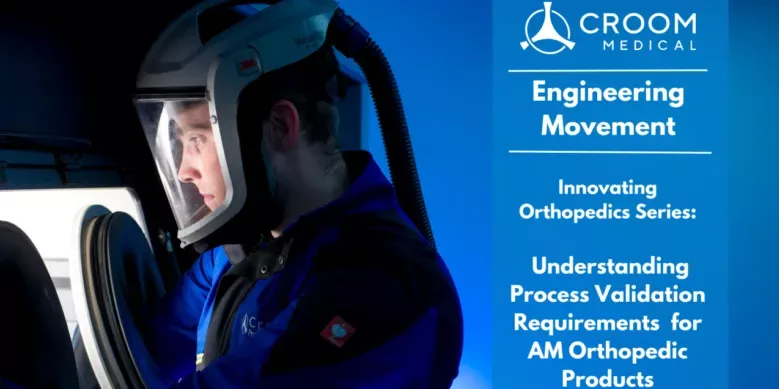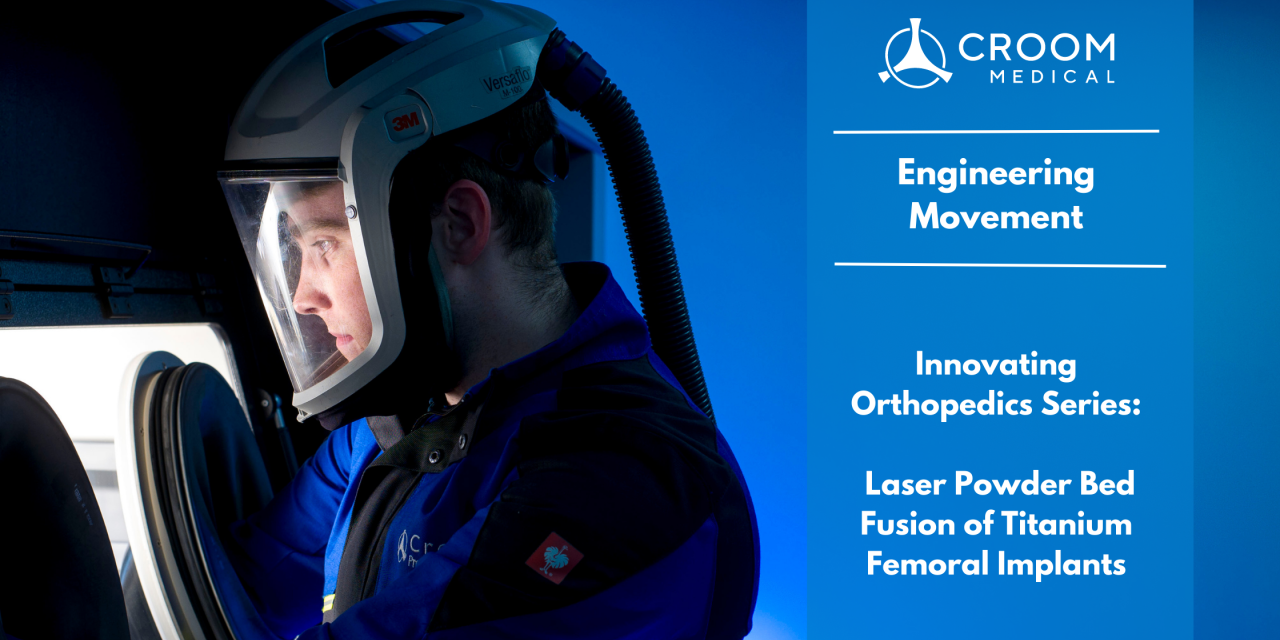
Croom Medical has been a pioneer in the development of metallic additive manufacturing within the SME orthopedic sector since 2010. With Additive Manufacturing (AM) and particularly laser powder bed fusion (LPBF) technology gaining substantial traction in the orthopedic industry, this blog post aims to explore the process validation requirements for LPBF technology in the context of orthopedic products. We will delve into material selection, process parameter optimization, Croom Medical’s post-processing technologies, quality control, and cost considerations. Additionally, we will examine the risks and drawbacks of this approach, providing specific examples of how LPBF can be effectively employed in various aspects of the manufacturing process.
Section 1: Overview of Laser Powder Bed Fusion (LPBF) Technology
Laser powder bed fusion (LPBF) is an additive manufacturing process that utilizes a high-powered laser to selectively melt and fuse layers of powdered material, gradually building up a part layer-by-layer. This technology is particularly suited for the production of orthopedic implants due to its ability to create intricate, patient-specific geometries that cannot be achieved through traditional manufacturing methods.
In LPBF, a thin layer of powder is spread across the build platform, and a laser scans the predefined pattern, melting and fusing the material in its path. After each layer is completed, the build platform descends, and a new layer of powder is spread, with the process repeating until the part is complete. The unsintered powder acts as a support structure for overhanging features and is removed after the build is finished.
Croom Medical has four production LPBF systems in place.
Section 2: Material Selection for Orthopedic Implants
The choice of materials is of paramount importance in the fabrication of orthopedic implants using Laser Powder Bed Fusion (LPBF), as they must be biocompatible, possess the required mechanical properties, and be compatible with the processing technology. Widely used materials for orthopedic implants include titanium alloys like Ti6Al4V, stainless steels such as 316L, and more recently, tantalum (Ta) as pioneered by Croom Medical.
Titanium alloys are highly sought-after due to their exceptional strength-to-weight ratio, corrosion resistance, and biocompatibility. Though stainless steels are employed less frequently, they offer cost benefits and reliable corrosion resistance. When choosing a material, it is crucial to adhere to regulatory requirements, including ASTM or ISO standards, to ensure the safety and efficacy of the final implant.
Section 3: Process Parameter Optimization
Optimizing process parameters in LPBF is essential for producing high-quality orthopedic implants. Key parameters such as laser power, scan speed, hatch spacing, and layer thickness must be carefully adjusted, taking into consideration the material, part geometry, and desired mechanical properties.
To determine the optimal process parameters, the Design of Experiments (DOE) method is commonly utilized. DOE systematically varies input factors, observes their impact on output, and ultimately minimizes trial-and-error iterations while reducing material waste.
After identifying the optimal parameters, it is crucial to validate them to guarantee repeatability and consistency across multiple production runs. This is accomplished by conducting a series of test builds and assessing the resulting parts for quality and adherence to specifications. Croom Medical has successfully completed these steps for various materials and DOE projects for several of its esteemed clients.
Section 4: Post-Processing of LPBF Orthopedic Implants
At Croom Medical, we have pioneered cost-effective solutions to streamline the post-processing stage of Laser Powder Bed Fusion (LPBF) orthopedic implants, an often-overlooked yet crucial step in ensuring a high-quality final product. Following the creation of an implant using LPBF, various post-processing steps are necessary to meet stringent specifications:
- Support Removal: During LPBF, support structures are utilized to prevent distortion or collapse. Once the implant is complete, these supports must be removed either manually or through automated methods, depending on the complexity of the part.
- Heat Treatment: To alleviate residual stresses and enhance the implant’s mechanical properties, heat treatment may be required. This procedure involves heating the part to a specific temperature, maintaining it for a set duration, and then cooling it at a controlled rate.
- Surface Finishing: Orthopedic implants often necessitate a particular surface finish to ensure proper functionality and biocompatibility. This can be achieved through various techniques, such as bead blasting, electrochemical polishing, or surface grinding. In some instances, a porous surface may be desired to encourage bone ingrowth and implant integration.
- Sterilization: Prior to implantation, orthopedic devices must undergo sterilization to remove any potential contaminants. Widely-used sterilization methods include autoclaving, gamma irradiation, and ethylene oxide gas.
Section 5: Quality Control and Inspection
Quality control is crucial in the manufacturing of orthopedic implants, as they must adhere to stringent regulatory standards and guarantee patient safety. Croom Medical employs various quality systems and processes, such as the following inspection methods for Laser Powder Bed Fusion (LPBF)-produced implants:
- Dimensional Inspection: It is essential to verify the implant’s dimensions to ensure compliance with design specifications. Croom Medical utilizes traditional methods, such as calipers, micrometers, and gauges, as well as advanced techniques like 3D scanning and coordinate measuring machines (CMMs). The company is equipped with several CMM machines in both the materials testing lab and the production floor.
- Surface Roughness Measurement: The surface finish of an implant significantly impacts its performance and biocompatibility. Surface roughness can be assessed using profilometers or optical inspection techniques.
- Material Analysis: Croom Medical’s in-house materials lab sets the company apart, offering unparalleled mechanical, morphological, and chemical testing capabilities. Material composition and quality can be confirmed using techniques such as X-ray fluorescence (XRF) or energy-dispersive X-ray spectroscopy (EDS).
- Mechanical Testing: To ensure the required strength and fatigue properties are met, implants must undergo mechanical testing, including tensile, compressive, and fatigue tests.
- Non-Destructive Testing (NDT): NDT methods, like X-ray or computed tomography (CT) scanning, can detect internal defects or porosity in the implant without causing any damage. Croom Medical boasts a fully-equipped NDT inspection line for both production and testing capabilities.
Section 6: Cost Considerations in LPBF for Orthopedic Implants
While LPBF offers numerous advantages for orthopedic implant production, it is essential to consider the associated costs to ensure a cost-effective approach. Factors that can influence the cost of LPBF-produced implants include:
- Material cost: The price of the raw material, such as titanium powder, can be a significant factor in the overall cost of the implant. Powder recycling and minimizing waste are essential to reduce material costs.
- Build time: The time required to produce a part using LPBF depends on factors such as part size, complexity, and the chosen process parameters. Longer build times can result in higher costs due to increased machine usage and energy consumption.
- Post-processing: As mentioned earlier, post-processing steps can be labor-intensive and time-consuming, adding to the overall cost of the implant. Optimizing these processes and utilizing automated methods where possible can help reduce costs.
- Quality control and inspection: Ensuring the quality of the produced implant is crucial but can be expensive, particularly when using advanced inspection techniques like CT scanning. Balancing the need for thorough inspection with cost considerations is essential.
Section 7: Process Validation for LPBF Orthopedic Implants
Process validation is a critical aspect of manufacturing orthopedic implants using LPBF technology. It involves establishing documented evidence that the process consistently produces a product that meets predetermined specifications and quality attributes. The process validation consists of three primary stages:
- Installation Qualification (IQ): This stage involves verifying that the LPBF equipment has been installed correctly and functions according to the manufacturer’s specifications. This can include checking the mechanical components, electrical systems, and software.
- Operational Qualification (OQ): The OQ stage focuses on ensuring that the process parameters and equipment can consistently operate within the predetermined limits. This involves testing various process parameters, such as laser power, scan speed, and layer thickness, to ensure repeatability and consistency across multiple production runs. It also includes verifying that any auxiliary equipment, such as powder handling systems and post-processing equipment, functions correctly and consistently.
- Performance Qualification (PQ): The final stage of process validation, PQ, involves demonstrating that the LPBF process can consistently produce orthopedic implants that meet the required specifications under real-world production conditions. This typically requires a series of test builds, followed by comprehensive inspection and testing of the produced parts to confirm their quality and conformance to design requirements.
Section 8: Risks and Downsides of LPBF for Orthopedic Implants
While Laser Powder Bed Fusion (LPBF) provides numerous benefits in the manufacturing of orthopedic implants, it is essential to be aware of the potential risks and limitations of this technology:
- Porosity and internal defects: Factors like insufficient laser power or inadequate powder spreading may cause internal porosity or defects in parts produced through LPBF. These imperfections can negatively impact the implant’s mechanical properties and overall performance. To address this issue, Croom Medical employs various heat treatment processes.
- Residual stresses: The rapid heating and cooling cycles during the LPBF process can lead to residual stresses within the part, causing warping or distortion if not managed through appropriate post-processing steps, such as heat treatment. Croom Medical utilizes several heat treatment techniques to mitigate these defects.
- Limited material options: Although LPBF is compatible with a wide range of materials, it cannot accommodate all materials used in orthopedic implants, such as certain biocompatible polymers or ceramics. This limitation can restrict the technology’s applicability in some instances.
- High initial investment: The cost of acquiring LPBF equipment and the necessary facilities can be considerable, especially for smaller manufacturers. This substantial initial investment may pose a barrier to entry for some organizations. However, Croom Medical has made significant investments in these processes over the past decade.
Conclusion
Croom Medical has established itself as an industry leader in harnessing the transformative potential of Laser Powder Bed Fusion (LPBF) technology to revolutionize the orthopedic implant industry. By enabling the production of patient-specific, intricate implants that are unattainable through traditional manufacturing methods, Croom Medical is at the forefront of advancing orthopedic solutions.
The company’s investment in a highly-skilled PhD team demonstrates their commitment to delivering exceptional products to the market with unparalleled efficiency and cost-effectiveness. This allows Croom Medical to cater to the needs of its esteemed blue-chip clientele, providing reliable and innovative solutions.
Croom Medical’s comprehensive understanding of various factors, such as process validation requirements, material selection, process parameter optimization, post-processing, quality control, and cost considerations, has positioned them as the go-to expert in leveraging LPBF technology for high-quality, cost-effective orthopedic products.
By proactively addressing the risks and drawbacks associated with LPBF, Croom Medical ensures the optimization of this groundbreaking technology while maintaining the highest standards of safety and effectiveness for the final orthopedic implant products.
With a proven track record of excellence and innovation, Croom Medical instills confidence in its clients and partners, making them the ideal choice for those seeking to explore additive manufacturing within orthopedics. To learn more about Croom Medical’s cutting-edge solutions, do not hesitate to reach out and discover how they can revolutionize your orthopedic product offerings.
References
1. Code of Federal Regulations, Title 21, Volume 8, Part 820. https://www.ecfr.gov/current/title-21/chapter-I/subchapter-H/part-820?toc=1
2. EU Guidelines for Good Manufacturing Practice for Medicinal Products for Human and Veterinary Use, Annex 15: Qualification and Validation, 2015. https://ec.europa.eu/health/system/files/2016-11/2015-10_annex15_0.pdf
3. Federal Register: October 7, 1996, Volume 61, Number 195, Rules and Regulations, Page 52631. https://www.govinfo.gov/content/pkg/FR-1996-10-07/pdf/96-25720.pdf
4. Current Good Manufacturing Practices Process Validation: General Principles and Practices; Revision 1; 2011. https://www.fda.gov/files/drugs/published/Process-Validation–General-Principles-and-Practices.pdf
5. FDA Class I and Class II Device Exemptions. https://www.fda.gov/medical-devices/classify-your-medical-device/class-i-and-class-ii-device-exemptions
6. Guide to Inspections of Medical Device Manufacturers December 1997. https://www.fda.gov/inspections-compliance-enforcement-and-criminal-investigations/inspection-guides/page-9
7. The Global Harmonization Task Force; Quality Management Systems; Process Validation Guidance; Edition 2 – January 2004. https://www.imdrf.org/sites/default/files/docs/ghtf/final/sg3/technical-docs/ghtf-sg3-n99-10-2004-qms-process-guidance-04010.pdf
8. ASTM A967/A967M Standard Specification for Chemical Passivation Treatments for Stainless Steel Parts

